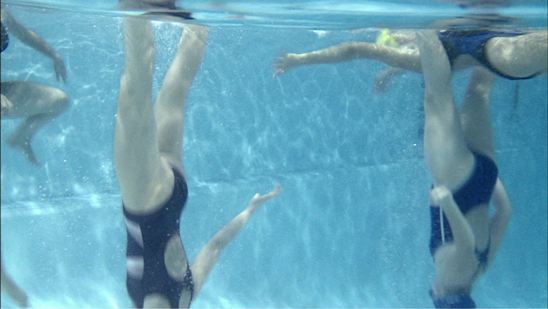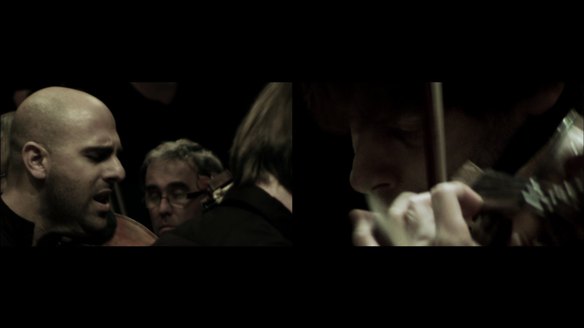Douglas Gordon: K 364 | reviews, news & interviews
Douglas Gordon: K.364
Douglas Gordon: K.364
Nice music - but Gordon's sleight-of-hand trickery adds nothing
After writing about a recent survey of French artist Philippe Parreno at the Serpentine Gallery last year, I found myself wondering about his collaboration with the Scottish artist Douglas Gordon. In 2006 the two artists made the acclaimed film Zidane: A 21st Century Portrait, and while Parreno’s skills as a film-maker were pretty evident from that first UK solo exhibition, Gordon’s talents must surely lie elsewhere - that is, outside the frame. Neither technically ambitious nor visually seductive, his films are not even meant to be seen in their entirety, certainly not his 1993 24-hour Psycho, which is simply a frame-by-frame re-presentation of the Hitchcock classic.
So where does this “elsewhere” lie? And why does he, 15 years after winning the Turner Prize, continue to beguile and intrigue? I must admit I’m not altogether sure. Neither am I wholly convinced. His 2002 Hayward Gallery survey certainly involved quite a bit of neat illusionistic trickery, which was fun for some and frankly creepy for others, and the themes that have preoccupied him since - dualities, doubles, shadows, good versus evil, creation versus destruction - are packed with a compelling narrative impetus (naturally, being Scottish, he’s been very taken with Stevenson’s Dr Jekyll and Mr Hyde). But where does that interest lead us? Through darker, more intriguing alleys? Or do we come out of the other side feeling as if it’s all been a bit smoke and mirrors?
There are certainly a few cunningly placed mirrors in this exhibition. As you enter the main gallery, mirrors either side fool you as points of entry, whilst straight ahead you appear to face a long, narrow corridor. This in turn appears to adjoin a second, brightly lit room, in contrast to the gloom of the main space. But, in fact, that is nothing other than a reflection, too, a fact that might take you several minutes rather than seconds to work out. (You'd think you’d recognise yourself pretty quickly in a line-up, but how genuinely, shockingly foreign our movements and gestures can appear to us).
 Borrowing its title from Mozart’s Sinfonia Concertante in E-flat major, also known as Kochel Composition K 364, the work features two cinematic screens which face each other. Different but related film footage plays on either screen and the footage is reflected in mirrors placed behind each screen: a train journey; desolate, sparsely wooded vistas; tracks disappearing into the horizon; a passenger talking, in fragments - about his mother, her Polish heritage, about “homeland”, whatever that may mean; synchronised swimming; circles of diffuse light dancing against dark. Finally, a stirring recital of Mozart’s K 364, glorious and enveloping.
Borrowing its title from Mozart’s Sinfonia Concertante in E-flat major, also known as Kochel Composition K 364, the work features two cinematic screens which face each other. Different but related film footage plays on either screen and the footage is reflected in mirrors placed behind each screen: a train journey; desolate, sparsely wooded vistas; tracks disappearing into the horizon; a passenger talking, in fragments - about his mother, her Polish heritage, about “homeland”, whatever that may mean; synchronised swimming; circles of diffuse light dancing against dark. Finally, a stirring recital of Mozart’s K 364, glorious and enveloping.
 But the glory belongs to Mozart and the musicians alone. The work meditates on history in a kind of loose, insubstantial fashion, hitching a ride, as it were: two Israeli musicians are travelling from Berlin to Warsaw to perform at the Philharmonic concert hall. On the way they pass Poznan, where the public baths used to house a synagogue. The journey seems agonisingly slow, interspersed as it is by desultory, Impressionistic fragments. “The sublime beauty of music can transcend the banality of evil”; “Out of destruction comes creation”. One can finally tease out such messages from the work. But, as for the rest - the spooky doubling and mirroring - what do they really add? Are we supposed to be having fun, or are we to be profoundly moved? Gordon’s sleight-of-hand trickery has been a witty enough distraction, but is too slight to persuade in either direction.
But the glory belongs to Mozart and the musicians alone. The work meditates on history in a kind of loose, insubstantial fashion, hitching a ride, as it were: two Israeli musicians are travelling from Berlin to Warsaw to perform at the Philharmonic concert hall. On the way they pass Poznan, where the public baths used to house a synagogue. The journey seems agonisingly slow, interspersed as it is by desultory, Impressionistic fragments. “The sublime beauty of music can transcend the banality of evil”; “Out of destruction comes creation”. One can finally tease out such messages from the work. But, as for the rest - the spooky doubling and mirroring - what do they really add? Are we supposed to be having fun, or are we to be profoundly moved? Gordon’s sleight-of-hand trickery has been a witty enough distraction, but is too slight to persuade in either direction.
Elsewhere, a ragged installation could be a doubling of Gordon’s studio: pictures and postcards, thematically arranged on the wall; smashed mirrors and skull fragments in a pulled-out drawer, tightly rolled-up notes in another; empty wine bottles on a sill. Biographical snapshots, past work, abiding preoccupations. The myth of the fast and loose-living artist loosely repackaged as art? Everything Gordon adds merely subtracts, until you are left to make sense of ever-more elusive fragments. Patchy ideas endlessly revisited.
- Douglas Gordon at Gagosian Gallery until 26 March
- Read theartsdesk Q&A: Douglas Gordon
- Find Zidane: A 21st Century Portrait on Amazon
Share this article
more Visual arts
 Eye to Eye: Homage to Ernst Scheidegger, MASI Lugano review - era-defining artist portraits
One of Switzerland's greatest photographers celebrated with a major retrospective
Eye to Eye: Homage to Ernst Scheidegger, MASI Lugano review - era-defining artist portraits
One of Switzerland's greatest photographers celebrated with a major retrospective
 Stephen review - a breathtakingly good first feature by a multi-media artist
Melanie Manchot's debut is strikingly intelligent and compelling
Stephen review - a breathtakingly good first feature by a multi-media artist
Melanie Manchot's debut is strikingly intelligent and compelling
 Fantastic Machine review - photography's story from one camera to 45 billion
Love it or hate it, the photographic image has ensnared us all
Fantastic Machine review - photography's story from one camera to 45 billion
Love it or hate it, the photographic image has ensnared us all
 Yinka Shonibare: Suspended States, Serpentine Gallery review - pure delight
Weighty subject matter treated with the lightest of touch
Yinka Shonibare: Suspended States, Serpentine Gallery review - pure delight
Weighty subject matter treated with the lightest of touch
 Jane Harris: Ellipse, Frac Nouvelle-Aquitaine MÉCA, Bordeaux review - ovals to the fore
Persistence and conviction in the works of the late English painter
Jane Harris: Ellipse, Frac Nouvelle-Aquitaine MÉCA, Bordeaux review - ovals to the fore
Persistence and conviction in the works of the late English painter
 Sargent and Fashion, Tate Britain review - portraiture as a performance
London’s elite posing dressed up to the nines
Sargent and Fashion, Tate Britain review - portraiture as a performance
London’s elite posing dressed up to the nines
 Zineb Sedira: Dreams Have No Titles, Whitechapel Gallery review - a disorientating mix of fact and fiction
An exhibition that begs the question 'What and where is home?'
Zineb Sedira: Dreams Have No Titles, Whitechapel Gallery review - a disorientating mix of fact and fiction
An exhibition that begs the question 'What and where is home?'
 Yoko Ono: Music of the Mind, Tate Modern review - a fitting celebration of the early years
Acknowledgement as a major avant garde artist comes at 90
Yoko Ono: Music of the Mind, Tate Modern review - a fitting celebration of the early years
Acknowledgement as a major avant garde artist comes at 90
 Unravel: The Power and Politics of Textiles in Art, Barbican review - the fabric of dissent
An ambitious exploration of a neglected medium
Unravel: The Power and Politics of Textiles in Art, Barbican review - the fabric of dissent
An ambitious exploration of a neglected medium
 When Forms Come Alive, Hayward Gallery review - how to reduce good art to family fun
Seriously good sculptures presented as little more than playthings or jokes
When Forms Come Alive, Hayward Gallery review - how to reduce good art to family fun
Seriously good sculptures presented as little more than playthings or jokes
 Entangled Pasts 1768-now, Royal Academy review - an institution exploring its racist past
After a long, slow journey from invisibility to agency, black people finally get a look in
Entangled Pasts 1768-now, Royal Academy review - an institution exploring its racist past
After a long, slow journey from invisibility to agency, black people finally get a look in
 Barbara Kruger, Serpentine Gallery review - clever, funny and chilling installations
Exploring the lies, deceptions and hyperbole used to cajole, bully and manipulate us
Barbara Kruger, Serpentine Gallery review - clever, funny and chilling installations
Exploring the lies, deceptions and hyperbole used to cajole, bully and manipulate us

Add comment